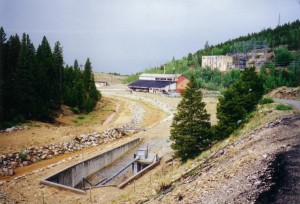By Hal Walter
I was running third place in the last couple miles of the Buena Vista Gold Rush Pack-Burro Race and had just regained much of the ground I’d lost to the leaders. In fact, I’d just seen them turn off the Midland Railroad Grade and onto the steep and rocky trail that leads down to town and the finish.
I followed in their footsteps, anxious to catch back up to them before a final push to the finish line. I was already visualizing catching and passing them on the street.
That’s when I tripped on a rock and went careening toward a big piñon tree.
I could see the trunk approaching at high speed. Since I had a lead rope in my left hand, I instinctively raised my right arm in football stiff-arm fashion to absorb the impact. I bounced off the tree sideways, bloody from some scrapes with smaller branches, and somehow regained my balance while stumbling downhill and not losing my grip on the rope as the burro continued on with a half-ton of momentum.
It was by far the most athletic thing I’d done the entire race, but my confidence was shaken and my notion of making a run for first place was vanquished. I was happy to trot on in for third. Because, hey, I could have been going somewhere else in an ambulance or worse.
Part of the allure in mountain sports is the inherent danger. And every now and then, someone gets hurt badly or dies. This is not limited to crashes or run-ins with the mountain elements such as lightning or temperature extremes; sometimes these sports find health problems, as happened recently when a cyclist died of an apparent heart failure during the Leadville Trail 100 MTB.
It’s an unspoken part of the thrill of participation. Mountain sports are inherently dangerous and attract “adrenaline junkies.” Though people rarely actually get hurt badly or die, the risk is actually part of the appeal for many.
Now for the average person, this may actually seem a little crazy, but then look how many thousands of people pay to raft the Arkansas River each year. At least six boaters, including two kayakers, died on the river this season. Additionally, a hiker was killed by lightning while hiking on Mount Yale, and a pro mountain biker died of injuries sustained in a fatal crash during a race in Crested Butte this summer.
In the sport of pack-burro racing, we’ve witnessed an explosion of entries in recent years. This year’s Fairplay World Championship attracted more than 60 runners for the short and long courses. It concerns me that many of these runners have very little knowledge or experience working with large animals. Even a small burro can be very dangerous in certain circumstances and can kick or pull a runner off his or her feet. Add to this the danger of the mountain environment and elements. This ain’t donkey basketball.
The annual Leadville Race Series attracts hundreds of entrants annually to its events, including the Leadville Trail 100 and the MTB 100 in which the cyclist died of a heart attack. The race began with the ultramarathon run back in 1983. I actually finished the ultra myself in 1989. The mountain biker, who had finished the MTB race 18 times previously, was in the last few miles of the event when his heart failed. The issue of heart attacks in endurance athletes is a much more complicated topic, but it cannot be separated from this discussion – we are talking about extreme tests of the cardiovascular system at high altitudes.
As a society, we have been conditioned to equate fitness with health. It’s a big part of how marketers sell us fitness gear and equipment, and even get us to participate in events. In my work as an editor for fitness and health guru Dr. Phil Maffetone I have learned what many people do not realize – that health and fitness are actually two very different things. One can have one without the other. For example, a very fit individual can have underlying heart problems that can strike tragically while that person is racing or training.
What’s more, in many cases these heart attacks may actually be brought on over time by extreme training programs. This has the potential to create a dangerous metabolic cocktail of inflammation, oxidative stress and hormonal imbalance. In fact, some scientific studies have begun to link marathon running to heart problems.
Indeed, the very idea of a marathon-distance race of 26.2 miles was born out of the history of the ancient Greek runner Pheidippides, who died after running from Marathon to Athens, Greece, to deliver news of a military victory.
And we’ve seen this scenario time and again in modern times, from the highly publicized death of Jim Fixx, author of The Complete Book of Running, who died of a heart attack while running at the age of 52, to more recently the death of 58-year-old ultramarathon running icon Micah True, a personal friend of mine and the central figure in Christopher McDougall’s New York Times bestseller Born to Run.
There is danger in the fun. And while it’s an unstated part of the allure, it’s also something that’s not largely discussed in our culture of mountain sports and activities. We see the standard news stories, often followed by the eulogy story where friends and family are interviewed about the deceased who “died doing what he loved doing.” Who really can argue with that?
Then we move on.
But rarely is there any real dialogue about the inherent danger in mountain sports beyond the waivers we sign. Whether it’s brought on by the extremes of the sports themselves, the mountain environment or the rigors of training and competition, it’s danger all the same. Do we as a mountain sports culture accept and embrace this reality, or do we just pretend it’s not reality at all? ?
Hal Walter’s book, Full Tilt Boogie – A journey into autism, fatherhood, and an epic test of man and beast, is available at The Book Haven in Salida, and also from Amazon.com.



